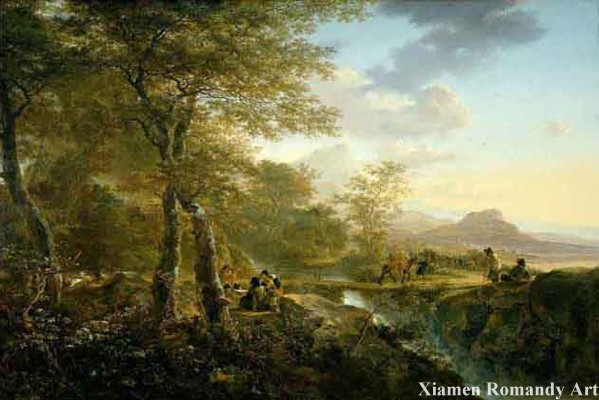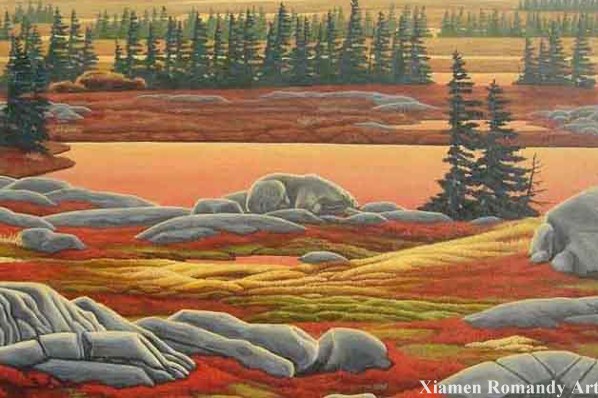Do you know how an oil painting is created?
The following article will guide you to learn the process of creating an oil painting:
The artist might sketch an outline of their subject prior to applying pigment to the surface. "Pigment" may be any number of natural substances with color, such as sulphur for yellow or cobalt for blue. The pigment is mixed with oil, usually linseed oil but other oils may be used as well. The various oils dry differently, creating assorted effects.
Traditionally, artists mixed their own paints from raw pigments they often ground themselves and medium. This made portability difficult and kept most painting activities confined to the studio. This changed in the late 1800s, when oil paint in tubes became widely available. Artists could mix colors quickly and easily, which enabled, for the first time, relatively convenient plein air (outdoor) painting (a common approach in French Impressionism).
The artist most often uses a brush to apply the paint. Brushes are made from a variety of fibers to create different effects. For example, brushes made with hog's bristle might be used for bolder strokes and impasto textures. Fitch hair and mongoose hair brushes are fine and smooth, and thus answer well for portraits and detail work. Even more expensive are red sable brushes (weasel hair). The finest quality brushes are called kolinsky sable; these brush fibers are taken from the tail of the Siberian mink. This hair keeps a superfine point, has smooth handling, and good memory (it returns to its original point when lifted off the canvas); this is known to artists as a brush's "snap."
In the past few decades, many synthetic brushes have come on the market. These are very durable and can be quite good, as well as cost efficient. Floppy fibers with no snap, such as squirrel hair, are generally not used by oil painters. Sizes of brushes also are widely varied and used for different effects. For example, a "round" is a pointed brush used for detail work. "Flat" brushes are used to apply broad swaths of color. "Bright" is a flat with shorter brush hairs. "Filbert" is a flat with rounded corners. "Egbert" is a very long "Filbert" and is rare. The artist might also apply paint with a palette knife, which is a flat, metal blade. A palette knife may also be used to remove paint from the canvas when necessary. A variety of unconventional tools, such as rags, sponges, and cotton swabs, may be used. Some artists even paint with their fingers.
 Most artists paint in layers, which is simply called "Indirect Painting". The method was first perfected through an adaptation of the Egg tempera painting technique and was applied by the Flemish painters in Northern Europe with pigments ground in linseed oil. More recently, this approach has been called the "Mixed Technique" or "Mixed Method". The first coat (also called "underpainting") is laid down, often painted with egg tempera or turpentine-thinned paint. This layer helps to "tone" the canvas and to cover the white of the gesso. Many artists use this layer to sketch out the composition. This first layer can be adjusted before moving forward, an advantage over the 'cartooning' method used in Fresco technique. After this layer dries, the artist might then proceed by painting a "mosaic" of color swatches, working from darkest to lightest. The borders of the colors are blended together when the "mosaic" is completed. This mosaic layer is then left to dry before applying details. Most artists paint in layers, which is simply called "Indirect Painting". The method was first perfected through an adaptation of the Egg tempera painting technique and was applied by the Flemish painters in Northern Europe with pigments ground in linseed oil. More recently, this approach has been called the "Mixed Technique" or "Mixed Method". The first coat (also called "underpainting") is laid down, often painted with egg tempera or turpentine-thinned paint. This layer helps to "tone" the canvas and to cover the white of the gesso. Many artists use this layer to sketch out the composition. This first layer can be adjusted before moving forward, an advantage over the 'cartooning' method used in Fresco technique. After this layer dries, the artist might then proceed by painting a "mosaic" of color swatches, working from darkest to lightest. The borders of the colors are blended together when the "mosaic" is completed. This mosaic layer is then left to dry before applying details.
The artist may apply several layers of details using a technique called 'fat over lean.' This means that each additional layer of paint is a bit oilier (it has more "fat") than the layer below, which allows proper drying. As a painting receives additional layers, the paint itself must become more oleo saturated (leaner-lower-layer to fatter-higher-layer) so that the final painting will not crack and peel. After it is dry, the artist might apply "glaze" to the painting, which is a thin, transparent layer, to seal the surface. A classical work might take weeks or even months to layer the paint, but the most skilled early artists, such as Jan van Eyck, sometimes worked more quickly using the Wet-on-wet method of painting for some details.
Artists in later periods, such as the impressionist era, often used this Wet-on-wet method more widely, blending the wet paint on the canvas without following the Renaissance-era approach of layering and glazing. This method (Wet-on-wet method) is also called "Alla Prima." This method was created due to the advent of painting outdoors instead of inside a studio. While outside, an artist did not have the time to let each layer of paint dry before adding a new layer. Several contemporary artists use a blend of both techniques, which can add bold color (wet-on-wet) as well as the depth of layers through glazing.
When the image is finished and has dried for up to a year, an artist often seals the work with a layer of varnish that is typically made from damar gum crystals dissolved in turpentine. Such varnishes can be removed without disturbing the oil painting itself, to enable cleaning and conservation. Some contemporary artists decide not to varnish their work, preferring that the surfaces remain varnish-free.
Refer to: http://en.wikipedia.org/wiki/Oil_painting
Edited by Kevin from Xiamen Romandy Art Limited.
(Xiamen Romandy Art is rofessional Oil Paintings suppliers from China. If you want to convert your photos into high quality oil paintings, or you want the masterpiece oil painting reproductions, please don't hesitate to contact with us.)
Romandy Art Website: http://www.oilpaintingcentre.com
Email: romandyart@gmail.com
(Tag: How to create an oil painting? The process of painting. )

|